(around 1994)
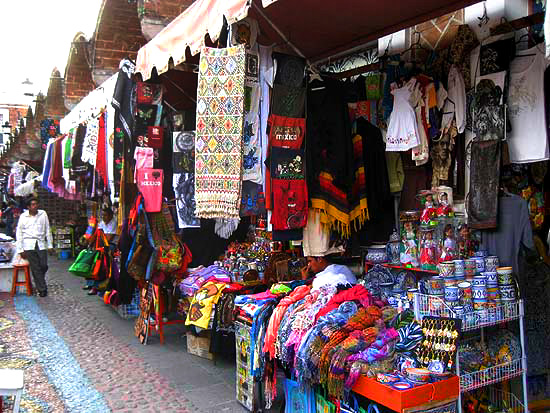 Stalls in Puebla's Parián Market, talavera visible here and there amid the textiles and trinkets; 2012 image courtesy of Malle Mäestu.
Stalls in Puebla's Parián Market, talavera visible here and there amid the textiles and trinkets; 2012 image courtesy of Malle Mäestu.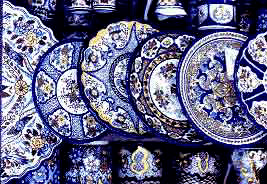
In downtown Puebla, Mexico, at 6 Norte entre 2 y 4 Oriente, Mercado El Parián doesn't look in the least like the traditional markets this site is all about. Mercado El Parián is a series of close-packed booths and stores clustered along both sides of a short alley, all jammed with Mexican handicraft displayed mainly for tourist consumption. El Parián would never be mentioned in this site about traditional Mexican markets but for one fact: it has existed since 1796, and therefor at least has deep roots as "our kind of mercado."
Surrounded by a group of English-speaking, camera-toting North Americans just piled off a tour bus, I pause before a stall with an especially striking display of mostly-blue plates, bowls, and urns. Immediately the store's operator steps forward. He is Javier Pérez Domínguez, a native of Puebla, about forty, well dressed, and businesslike. When he hears about this writing project he volunteers what he knows about the beautiful, mostly-blue ceramics he specializes in selling.
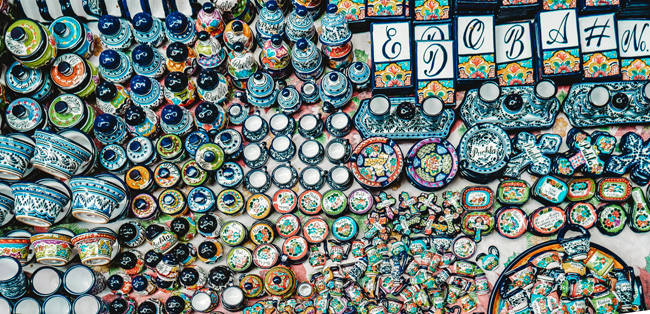
"What you see before you is a special kind of pottery for which Puebla is world renown. It's known as talavera." Sr. Pérez speaks as if he's made this presentation a million times before, and maybe he has. "The great majority of these works are bright blue because that's what's basic to talavera. The earliest talavera was strictly blue and white, but, later. other colors were added, such as orange, white, brown, and yellow."
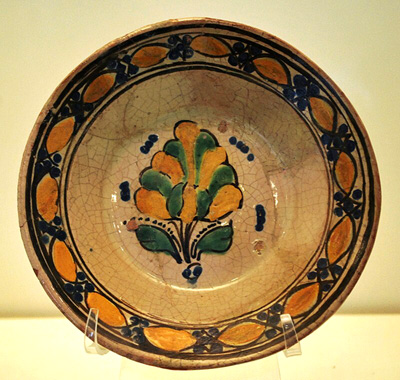
16 or 17th century green/yellow Talavera bowl from Puebla on display at the Museum of Artes Populares in Mexico City; copyright free image courtesy of "AlejandroLinaresGarcia" made available through Wikimedia Commons.
"Talavera originally came from Spain, from the town of Talavera de la Reina," he continues almost professorially. "During colonial times Franciscan monks brought the first talavera from Spain to here for adorning altars. Soon Mexican talavera was being made for other purposes. At first just the friars had it, but soon the rich began adorning their homes with it, and using it at their tables. Since those days the art of talavera-making has diversified tremendously, away from simple blue-and-white traditional patterns, to colors, mats, and forms that go far beyond the original utilitarianism, into pure decoration and ornamentation."
"One feature of talavera is that its handiwork is very fine, and done exclusively by hand. The pottery is baked at extremely high temperatures, so it is durable. It does not contain lead contamination, which many kinds of other pottery do. The clay of which talavera is made is reddish brown, extremely fine-textured, and extremely pure -- it goes through a purification process lasting twenty to twenty-five days. The clay must be so pure because, if it isn't, at the very high temperatures at which talavera is fired, if there is an impurity, the work will fracture. The clay comes from different locations around Puebla. After the purification process, they massage it, process it, then form the piece by hand on the pottery wheel. The artisan begins with reddish brown pottery, covers it with white, and then by hand adds the design in blue and other colors."
"The most critical part of making talavera is the preparation of the colors, because each color should be compatible not only with all the other colors, but also the enamel. Sometimes colors, once the object is fired in the oven, turn dark or react in an ugly way with the white part. One secret of firing talavera is getting all the pigments melting at the same temperature. Once the colors are applied, the pieces bake in the oven for an entire day. The family making the talavera is always busy with different stages of the production process for numerous pieces, so it's hard to say how long it takes for just one piece. However, you can say that it takes about a month from the time the purification of the clay begins until there is a finished product."
Javier continues his story without my prompting; he is a natural explainer, a spokesman for the excellence of his product.
"Since talavera is made by hand, every piece is different from every other piece; by no means is it a mass-produced product. Every talavera-making family has its own secret way of making it. And it's the same way with the colors; every color has its own secret formula which the family guards very closely, and which has been passed down from one generation to the other. After thirty years of working in this business, I can just look at a piece of pottery from Puebla and know which family made it. Right now there are about ten families in Puebla making talavera. From time to time individuals come along trying it, or the kids strike out on their own, but, more or less, there are about ten."
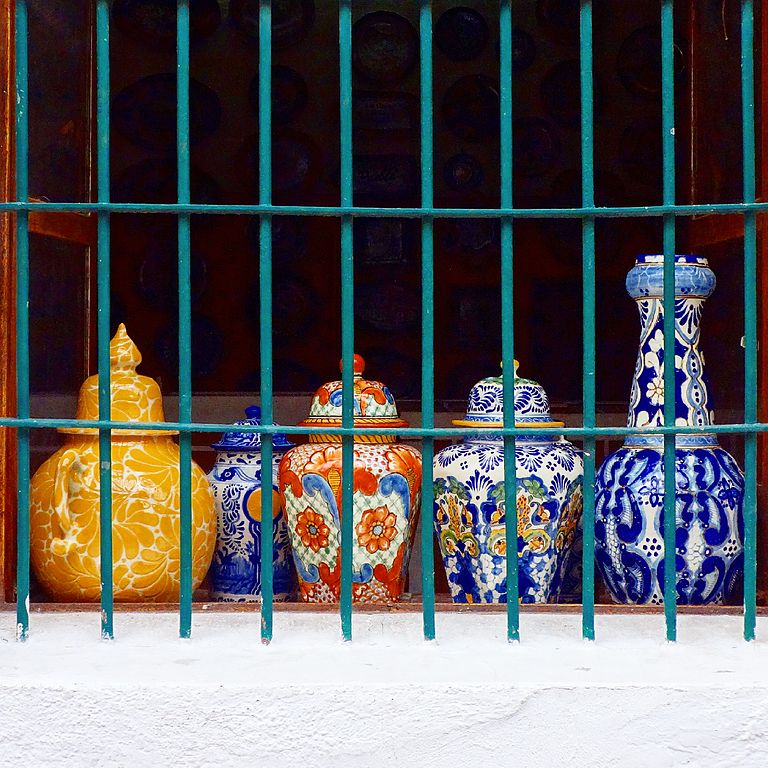
"Talavera lasts for centuries; it is something to present to the family. In Puebla, the old cathedrals have their cupolas covered with talavera. That talavera for 500 years has been exposed to sun, wind, rain, and heat, but today it continues to be bright and hold its colors; you can see this for yourself just walking around Puebla. Our handmade talavera is as long- lasting as any ceramic product produced by industry. I've had very fine ceramic pieces from Germany and Italy, but their colors simply don't match those of our talavera. Usually only dull colors survive the fiery temperatures used by talavera, but our artists have figured out how to use bright ones. Even the Spanish who have the original talavera in their country buy our talavera, because our colors are prettier than theirs. They use only blue and white, so their talavera is very sober. We have many colors, which Mexicans like, so ours is very Mexican, and you have to admit, prettier."